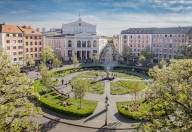
The Glockenbachviertel has undergone many metamorphoses: from a working-class neighborhood to an artists' quarter, from the heart of Munich's gay scene to a hipster hotspot. Each of these phases has left its mark on the character of the area. The walk begins in the enchanting Old South Cemetery (Alter Südfriedhof) and ends on the Museum Island – in between, the streets are full of life.
As soon as you enter the Old South Cemetery, you’re enveloped in silence and charming greenery. For eighty years, this former plague cemetery outside the city walls was Munich’s only burial ground. That’s why you’ll find the graves of many prominent Munich citizens from the 18th to the 20th century here, such as architect Friedrich von Gärtner, women’s rights activist Ellen Ammann, or physicist Georg Simon Ohm. Now a listed site, the cemetery has become a fairytale-like park with arcades and many squirrels. Fun fact: the layout of the oldest section of the cemetery is designed to resemble a sarcophagus.
Müllerstraße is home to many clubs and initiatives that reflect the queer history of the neighborhood. As early as the 1960s, the first gay bars appeared here. Combined with low rents, the area became a typical artists’ quarter and attracted many queer people. In the 1980s, Freddie Mercury was a regular guest at several bars in the area and known for throwing wild parties. Over time, more and more queer people moved in, transforming what was once a rough neighborhood into a creative and sought-after part of town. Even today, many bars and pubs catering to the queer community and its allies can be found in the side streets.
The beautiful Gärtnerplatz draws people like a magnet. On sunny days, you’ll find people gathering amid colorful flowers, listening to the bubbling fountain and the buzz of conversation. Or you might choose to dive into one of the six little streets radiating out from the roundabout.
Cin cin!
Glockenbach is also known for its nightlife and trendy scene. Anyone who enjoys a good drink should definitely visit one of its many bars.
Here, you’ll find everything needed for a hedonistic lifestyle: bars, restaurants, takeaways, hair salons, bookstores, small shops selling flowers, special delicacies, unique finds, souvenirs, and bargains of all kinds. Cultural entertainment is also covered: the Gärtnerplatz Theatre hosts operas, operettas, and musicals.
All paths here eventually lead to Fraunhoferstraße, which cuts through the district. Starting at Müllerstraße and ending at the Reichenbach Bridge, this long street is home to a wide variety of restaurants, bars, and rooftop terraces, as well as plenty of other interesting places: lamp, comic, and traditional costume shops, galleries, antique dealers, and liquor stores – you’ll even find pink gin here.
This church is worth a little detour: the twin towers of the Roman Catholic Church, also known as “Notre-Dame on the Isar,” are as iconic as its pastor. Rainer Maria Schießler has served here since the 1990s and is also a book author and podcaster.
One popular tradition is his “animal mass” (Viecherlmesse), where pets are welcome. The church was built between 1892 and 1908 in a neo-Romanesque style. Until its destruction during WWII, the towers had pointed spires, which were replaced with temporary "emergency roofs" that remain to this day.
Do as the locals do and grab a refreshment at the legendary 23-hour kiosk on the western riverbank. Whether with or without a drink, crossing the Reichenbach Bridge is simply fun. It leads from the Glockenbachviertel into the Au district and towards nature. Be sure to pause in the middle of the bridge and take in the view.
Looking south, the long chimneys of the iconic Sendling power station greet you on the right side of the river. A bit closer, the towers of St. Maximilian once again show off their finest side. People stretch their feet into the water from the wide stone steps on the riverbank, swimmers float with the current, and others relax on the tiny gravel islands in the middle of the river. If you haven’t yet experienced the Isar, this is where you’ll fall in love with it.
The landmark of the Deutsches Museum is visible from afar: the museum tower. It houses a modern weather station; its “clocks” display wind speed, air pressure, and more.
The walk ends downstream on the Museum Island. We walk north along the right side of the Isar toward the Cornelius Bridge, which leads to the island. At its southern tip, the “Kulturstrand” takes place in summer – offering live music, a beach bar, and a wide array of art and culture. Alongside the Deutsches Museum, the island also boasts a rooftop bar and “Blitz,” one of Munich’s trendiest clubs with a Mexican restaurant.
The tour is available for download here as a GPX file.